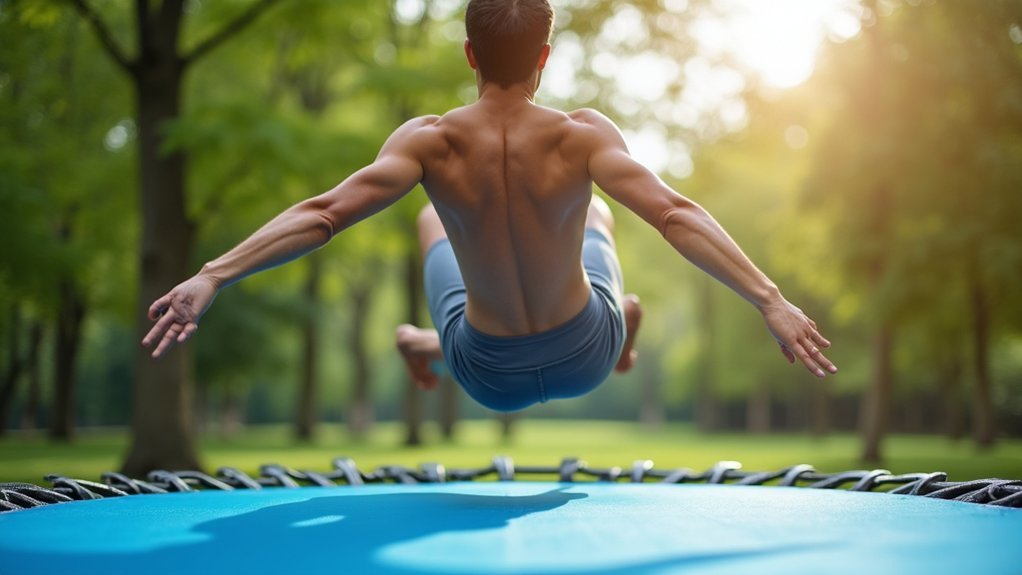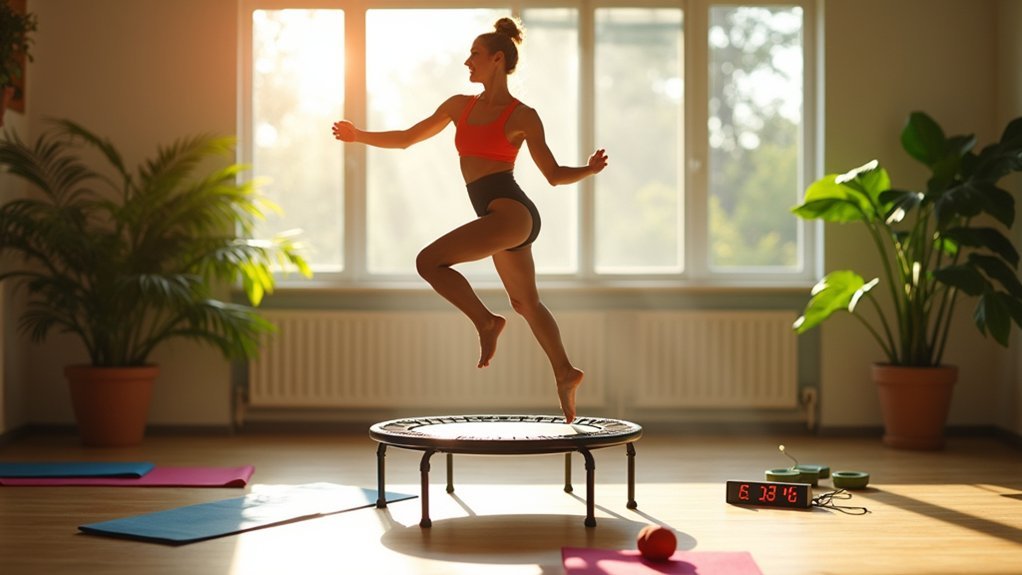Low-impact rebounding on a mini-trampoline strengthens your spine density in three key ways: it activates core and back muscles that support spinal alignment, stimulates bone formation through gentle weight-bearing movement, and improves balance to prevent falls and fractures. Regular 5-minute sessions throughout your day can markedly enhance bone health without risking compression injuries. These quick intervals offer convenient yet powerful benefits that compound over time, transforming your skeletal strength with minimal effort.
How Low-Impact Rebounding Activates Spine-Supporting Muscles

While traditional exercises often place strain on joints and vertebrae, low-impact rebounding offers a gentle yet effective way to strengthen your spine-supporting muscles. The bouncing motion on a mini-trampoline engages your core and back muscles, improving spinal alignment without risking compression fractures.
Exercise safely for your spine with rebounding—gentle bouncing that strengthens core muscles without joint strain.
When you rebound, you’re creating a weight-bearing effect that stimulates bone density production in your vertebrae. This is particularly valuable for individuals with osteoporosis who need gentler approaches to strengthen their bones.
You’ll also improve balance and coordination—crucial skills for preventing falls. The rhythmic movement enhances lymphatic circulation while activating muscles throughout your body.
Dedicating just 10-15 minutes a few times weekly to rebounding can dramatically improve overall spinal health, making it an efficient addition to your wellness routine.
The Role of Mini-Trampoline Sessions in Stimulating Bone Formation
Although many people overlook it, the gentle impact of mini-trampoline exercises triggers an essential biological response in your skeletal system. This low-impact, weight-bearing activity stimulates bone formation and increases bone density, particularly in your spine and lower extremities.
When you bounce, you’re creating dynamic loading that encourages bone remodeling—a process vital for those with low bone density. Research shows just 10-15 minutes a few times weekly can greatly enhance your bone health, making it an efficient addition to any osteoporosis management routine.
Beyond building stronger bones, you’ll improve your balance and coordination, reducing your risk of falls and fractures.
For a thorough approach to spine health, mini-trampoline sessions offer an accessible way to strengthen your skeletal system while enjoying a low-impact workout.
Incorporating 5-Minute Rebounding Intervals Throughout Your Day

Even with a busy schedule, incorporating 5-minute rebounding intervals throughout your day can dramatically improve your spine density. These short sessions stimulate weight-bearing activity that prompts bone tissue production, enhancing overall bone strength without high-impact stress.
Just 5 minutes of rebounding several times daily can transform spine density through gentle, weight-bearing stimulation.
You’ll find rebounding offers a low-impact alternative that’s safer than intense exercises while still providing moderate stimulation needed for bone health. These mini-sessions improve your balance and coordination, reducing your risk of falls and fractures if you have concerns about bone density.
Beyond spine density benefits, you’ll enjoy improved cardiovascular health, elevated mood, and increased energy levels.
The convenience factor can’t be overstated—place a mini-trampoline in your home or office to guarantee consistent physical activity becomes part of your daily routine.
Frequently Asked Questions
What Exercises Increase Spine Density?
You’ll boost spine density with weight-bearing activities like brisk walking, strength training exercises targeting back muscles, resistance training with weights, and spine-specific workouts like wall angels and bird-dog exercises.
How to Reverse Osteopenia in Spine?
You can reverse spine osteopenia through weight-bearing exercises like walking, resistance training with free weights, spinal extension movements, and maintaining proper posture. Always consult your healthcare provider for a personalized exercise plan.
Can You Rebuild Bone Density With Exercise?
Yes, you can rebuild bone density with exercise. Weight-bearing and resistance training stimulate bone formation, especially high-intensity activities. You’ll see best results when you’re consistent with strength training targeting your spine and major joints.
What Is the Fastest Way to Increase Bone Density?
The fastest way to increase bone density involves high-impact exercises like jumping, combined with progressive strength training and weight-bearing activities. You’ll need consistency – it’s not an overnight process, even with ideal approaches.
In Summary
You’ve discovered how mini-trampoline rebounding can transform your spine health in just minutes a day. By activating essential support muscles, stimulating bone formation, and fitting easily into your schedule, these short bouncing sessions deliver impressive benefits. Don’t underestimate the power of these five-minute intervals—they’re building spine density with every bounce. Start incorporating rebounding today and you’ll strengthen your framework for better posture and mobility tomorrow.




Leave a Reply